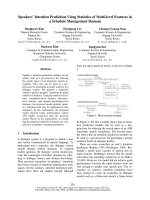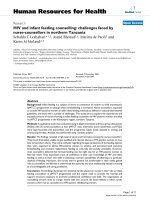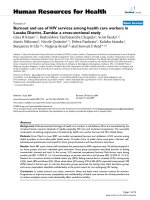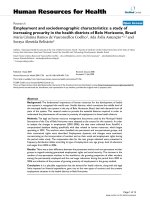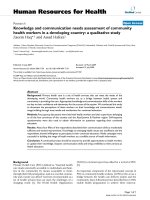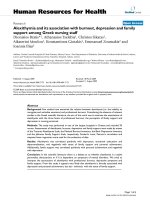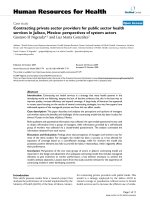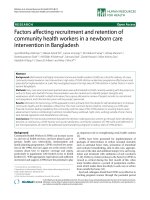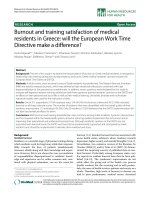báo cáo sinh học:" Knowledge and communication needs assessment of community health workers in a developing country: a qualitative study" docx
Bạn đang xem bản rút gọn của tài liệu. Xem và tải ngay bản đầy đủ của tài liệu tại đây (261.64 KB, 7 trang )
BioMed Central
Page 1 of 7
(page number not for citation purposes)
Human Resources for Health
Open Access
Research
Knowledge and communication needs assessment of community
health workers in a developing country: a qualitative study
Zaeem Haq*
1
and Assad Hafeez
2
Address:
1
Johns Hopkins University Centre for Communication Programs (PAIMAN), Islamabad, Pakistan and
2
Health Systems and Policy Unit,
Federal Ministry of Health, Islamabad, Pakistan
Email: Zaeem Haq* - ; Assad Hafeez -
* Corresponding author
Abstract
Background: Primary health care is a set of health services that can meet the needs of the
developing world. Community health workers act as a bridge between health system and
community in providing this care. Appropriate knowledge and communication skills of the workers
are key to their confidence and elementary for the success of the system. We conducted this study
to document the perceptions of these workers on their knowledge and communication needs,
image building through mass media and mechanisms for continued education.
Methods: Focus group discussions were held with health workers and their supervisors belonging
to all the four provinces of the country and the Azad Jammu & Kashmir region. Self-response
questionnaires were also used to obtain information on questions regarding their continued
education.
Results: About four fifths of the respondents described their communication skills as moderately
sufficient and wanted improvement. Knowledge on emerging health issues was insufficient and the
respondents showed willingness to participate in their continued education. Media campaigns were
successful in building the image of health workers as a credible source of health information.
Conclusion: A continued process should be ensured to provide opportunities to health workers
to update their knowledge, sharpen communication skills and bring credibility to their persona as
health educators.
Background
Primary Health Care (PHC) defined as "Essential health
care made universally accessible to individuals and fami-
lies in the community by means acceptable to them,
through their full participation, and at a cost that commu-
nity and country can afford" has been recommended as a
set of health services that can meet the challenges of a
changing world [1]. The World Health Organization
(WHO) in its latest report has called for a revival of PHC
[2].
An important component of the rejuvenated concept of
PHC is community health workers, (CHWs) who act as a
bridge between the health care delivery system and the
community. Mary & Rosemary have described how CHWs
enable health programmes to achieve three intercon-
Published: 21 July 2009
Human Resources for Health 2009, 7:59 doi:10.1186/1478-4491-7-59
Received: 12 March 2009
Accepted: 21 July 2009
This article is available from: />© 2009 Haq and Hafeez; licensee BioMed Central Ltd.
This is an Open Access article distributed under the terms of the Creative Commons Attribution License ( />),
which permits unrestricted use, distribution, and reproduction in any medium, provided the original work is properly cited.
Human Resources for Health 2009, 7:59 />Page 2 of 7
(page number not for citation purposes)
nected goals: building a relationship between the health
care provider and laypersons in the community; improv-
ing appropriate health care utilization; and educating
people to reduce health risks in their lives [3]. Highly chal-
lenging and innovative ideas such as serving 70% of a
population of 190 million in Brazil, skin-to-skin care for
newborns in India and improved perinatal care in Nepal
have worked remarkably well through CHWs [4-6].
Appropriate knowledge and interpersonal communica-
tion expertise, in addition to basic clinical skills, supplies
and supervision, are a key to the work of CHWs [7-9]. The
CHW can empower the community to identify its needs
and can assist in planning a strategy to achieve the desired
results. In order to accomplish this successfully, CHWs
should be culturally sensitive, with an ability to build a
strong community rapport.
The 100 000 Lady Health Workers (LHWs) of Pakistan's
Ministry of Health fit well into the definition of CHWs;
their programme is considered as one of the successful
large-scale community programmes [10]. Various evalua-
tions have enumerated the successes of this programme,
along with a few areas to ensure quality improvement
[11,12]. Regarding quality improvement, a number of
authors recommend devising strategies to improve health
worker education and training, and suggest that prefer-
ences of primary care workers should be known and dis-
cussed at the policy level [13,14].
None of the evaluations from Pakistan have sought the
workers' own perceptions regarding their knowledge and
communication capacity, however. We therefore con-
ducted this qualitative study in all provinces of Pakistan,
to know the perceptions of health workers and supervi-
sors on the communication capability of the LHW; ade-
quacy of their knowledge; effectiveness of the image-
building activities involving mass media; and mecha-
nisms for continued education.
Methods
The Ministry of Health, Government of Pakistan,
launched the National Programme for Family Planning
and Primary Health Care of Pakistan, also called the Lady
Health Workers Programme (LHWP) in 1994. Since then,
the programme has deployed about 100 000 LHWs and
more than 5000 Lady Health Supervisors (LHSs) in 135
districts of all the four provinces and regions of the coun-
try.
Providing appropriate and implementable health infor-
mation to rural households has been the cornerstone of
the programme's health promotion strategy. After recruit-
ment, its workers undergo 15 months of preparation:
three months of classroom training, followed by super-
vised fieldwork for one year. Refresher training sessions
are also conducted from time to time.
There is a system of supervision meetings every month in
which the 15 to 20 LHWs from the area share their
progress and problems with the supervisor. The pro-
gramme broadcasts issue-based communication cam-
paigns on television and other mass media in which the
LHW is positioned as an accessible and credible source of
health information to the rural household.
We conducted a multi-stage, stratified, random sampling
for this study. Under some of the donor-funded pro-
grammes, various initiatives for capacity building of the
LHW are being carried out selectively throughout the
country. To gauge the true programme situation, we
selected only those districts where no donor-funded
project was being implemented. These included two rural
districts of Attock and Charsaddah from the provinces of
Punjab and NWFP, and two urban districts of Karachi and
Quetta from the provinces of Sind and Baluchistan. Muz-
affarabad District was selected from the region of Azad
Jammu & Kashmir (AJK), while tribal regions could not be
considered because of the prevailing security situation in
those areas. In each district, the sample comprised all
LHWs and supervisors who were aged 20 to 50 years,
based at their respective villages, married or unmarried,
willing to participate in the study and having at least one
year of work experience.
It was a cross-sectional study consisting of two compo-
nents. Component 1 comprised focus group discussions
(FGDs) with LHWs and their supervisors; in component
2, information from the same LHWs and their supervisors
was obtained through a self-response questionnaire.
We developed guiding questions for the FGDs of compo-
nent 1 and a self-reporting questionnaire for component
2. Careful attention was given to how the questions on
"perceived barriers" would be asked during the FGD. We
included appropriate examples to explain the questions
uniformly across all the discussions. The questionnaires,
originally developed in English, were translated to Urdu.
The self-response questionnaire was back-translated as
well, according to the recommendations [15]. The ques-
tionnaires were pilot-tested with groups in Rawalpindi
District and appropriate changes made in the light of their
feedback.
Prior appointments were made before travelling to the
respective districts to conduct the discussions. Before for-
mal discussion, the purpose of the research was explained
to all the participants. The discussions held in Urdu and
were tape-recorded after obtaining participants' permis-
sion. Notes were also taken, so that no discussion point
Human Resources for Health 2009, 7:59 />Page 3 of 7
(page number not for citation purposes)
was missed. Discussions were carried out with the help of
guiding and probing questions. The self-reporting ques-
tionnaire was distributed among the participants at the
end of each FGD. The questionnaire was first explained,
after which the respondents filled in the required informa-
tion and returned the questionnaires to the facilitator.
Inductive analysis [16,17] was performed on the tran-
scripts and field notes through the following.
1. familiarization with the data, which included reading
the notes, transcribing the FGDs and translating the Urdu
transcript into English;
2. initial categorization by developing tables on themes
emerging from the discussions. Notes taken during the
discussions as well as the transcripts were consulted for
developing these tables to ensure as much rigor as possi-
ble.
3. identifying patterns and connections within and
between categories with the help of these tables;
4. entering data from the quantitative questionnaire into
the Statistical Package for Social Sciences;
5. reaching a final interpretation by combining all the
findings.
The answers of the majority were presented as the
"Response", while comments that were significant but not
shared by the majority were labelled as "Additional Com-
ments". The study was undertaken between 8 March 2008
and 15 August 2008. Ethical approval for the study was
obtained from the National Programme for Family Plan-
ning & Primary Health Care.
Results
Participants
A total of 105 participants, including 57 LHWs and 48
LHSs from five districts, participated in the research. They
took part in FGDs and also filled out the questionnaire.
The minimum number of participants in FGDs was seven
(Karachi), while the maximum was 16 (Muzaffarabad).
The mean age of the participant LHWs was 31 years (range
20–49). Among them, 88% were married, while 12% of
the LHW were not married. The number of participating
supervisors was 48, with a mean age of 30 years (range
23–50). Among the LHS, 92% were married, while 8%
belonged to the unmarried category (Table 1).
Communication skills
Out of the five groups of LHWs, four believed they pos-
sessed moderately sufficient communication skills (Table
2). The group from Quetta, however, thought they pos-
sessed insufficient skills. The same proportion (four
fifths) of the supervisors rated these skills as moderately
sufficient, while one group (Karachi) called the communi-
cation skills of their LHW as sufficient.
Communicating with males on family planning; estab-
lishing village health committees; convincing TB suspects
to make use of diagnostic facilities; and talking about
taboo subjects such as HIV/AIDS and other sexually trans-
mitted diseases (STDs) were reported as health issues on
which dialogue was difficult for the LHWs.
The respondents informed that nazr (evil eye), garam &
thanda (hot & cold) food, male child preference, fear of
stigma in TB and other diseases, and fatalism were the
common barriers perceived by the community. Talking
about the ways in which they addressed these barriers, the
workers reported using better child health leading to bet-
ter prospects for the family as an incentive for the people
to make desired changes in their behaviour. They also
Table 1: District-wise sociodemographic variables of the participants (n = 105)
LHW LHS
District No. Age range, years Mean age, years Married Unmarried No. Age range, years Mean age, years Married Unmarried
Attock 12 24–40 30 9 3 9 27–32 30 9 0
Charsaddah 8 22–40 30 8 0 9 25–35 28 9 0
Karachi 8 28–49 34 8 0 7 23–39 32 6 1
Muzaffarabad 16 27–44 30 14 2 11 24–36 29 9 2
Quetta 13 20–45 32 11 2 12 21–50 29 11 1
Total 57 20–49 31 50 7 48 21–50 30 44 4
Human Resources for Health 2009, 7:59 />Page 4 of 7
(page number not for citation purposes)
reported using religious teachings where appropriate;
using fear appeal; and seeking the help of influentials
(teachers, counsellors, peers) where available. The main
response of the majority of the supervisors was similar to
that of the workers.
The respondents suggested refresher training sessions that
include role plays on common difficult scenarios as a way
to improve communication skills of the workers (Table
2). They proposed that appropriate information and skills
to deal with people who were fixed on strong negative
feelings, such as "we are poor, we can't do anything" or "a
woman's only role is to serve the husband, kids and the
family" or "the life or death of the mother or newborn is
the will of God, in which the mortals cannot intervene"
would be really helpful. The workers also suggested that
information, education communication (IEC) materials
should be provided to them that could be carried to the
households and used for talking about specific health
issues.
Level of knowledge
Family planning (FP); maternal, newborn and child
health (MNCH); nutrition; malaria; the Expanded Pro-
gramme on Immunization (EPI) and common childhood
diseases (Table 3) were reported as topics on which the
workers had sufficient knowledge. Yet, they wanted more
knowledge on some of these issues, e.g. MNCH, FP and
communicable diseases such as TB. Emerging diseases
such as Congo fever, avian influenza or dengue fever were
reported as areas in which workers had insufficient knowl-
edge. According to workers, their community asked ques-
tions on these emerging diseases to which they (workers)
could not respond, as these topics were not a routine part
of their curriculum or training.
Table 2: Responses to the questions regarding communication skills
Question LHW LHS
Are they sufficient? Response Moderate (4/5)
Insufficient (1/5)
Sufficient (1/5)
Moderate (4/5)
Additional comments There is room for improvement LHWs with education <10 grades, not
married, or those having low SES face
more difficulty
How you deal with barriers
perceived by individuals?
Response By talking about child's future, using
religious teachings, using help of
influentials
Talking about child & family's future,
using religion, using local leaders
Additional comments Using fear appeal and using help of LHS
mentioned by some
Positive examples & using IEC materials,
helping with own hand
What are your specific suggestions
on the communications capacity
building of LHW?
Response Refresher training, role plays on
common difficult scenarios, better IEC
materials should be provided
Refresher training, role plays on
common difficult scenarios, better IEC
materials should be provided
Additional comments Adequacy and timeliness of the supply of
IEC materials should be improved
Quality of basic training should also be
improved
Table 3: Respondents' views on adequacy of technical knowledge
Question Response
LHW LHS
What are the topics on which you have
sufficient knowledge?
FP, MNCH, nutrition, malaria, EPI & common
childhood diseases
FP, MNCH, nutrition, malaria, EPI, common
childhood diseases & National Immunizations
Days
What are the topics on which you have
insufficient knowledge?
Emerging diseases, medicinal issues, questions
on repeated weighing and polio immunization
of babies are difficult topics
Emerging diseases, e.g. dengue fever, Congo
fever, avian influenza, etc.
Human Resources for Health 2009, 7:59 />Page 5 of 7
(page number not for citation purposes)
All the respondents thought some means of continuing
education would help them improve their areas of weak
knowledge. They liked the idea of receiving a regular pub-
lication from the programme. Out of the total, about 3%
of the respondents showed interest in receiving official or
administrative information and 40% were interested in
reading clinical (tibbi maalooomat) information, while
57% wanted both types of information in equal amounts
through such a publication.
The respondents were also asked whether a regular source
of information, such as a periodical sent from the pro-
gramme, would help them address the queries. A little
over 94% thought such a regular source of information
would help them respond to these questions (Figure 1).
Media campaigns
Respondents belonging to both categories in all the dis-
tricts liked their representation in the mass media. Table 4
describes their views as well as suggestions on these media
campaigns. They thought the media enhanced the credi-
bility of health workers as the messages on television
(TV), radio or newspapers were liked by their family and
community members. According to them, people
believed in the information provided by the LHW when a
similar message was concurrently shown on TV. The
supervisors thought the community respected the worker
and acknowledged her services after having seen TV com-
mercials (TVCs) about her roles and responsibilities. The
respondents suggested some modifications to improve
the mass media campaigns. In their view, using the genre
of television drama, adding male characters to the media
products and airing these campaigns on private cable TV
channels in addition to the state-run terrestrial channels
would help increase the effectiveness of these campaigns.
Discussion
To our knowledge, this is the first study that has explored
how community-level health workers see their own per-
formance. The workers and their supervisors acknowl-
edged that there was room for improvement in their
communication capacity. In spite of the attention given,
knowledge on some of the areas that were part of the orig-
inal curriculum remained weak, while at the same time
the evolving public health situation in the country
demanded addition of basic information on emerging
health issues to the training system. The idea of a regular
publication for continuing education of these workers
therefore was highly appreciated.
Dealing with barriers perceived by the community
requires communication skills in addition to updated
knowledge. Interestingly, without guidelines the workers
were using some of the recommended techniques, e.g. use
of positive examples or fear appeal [18], but they wanted
more capacity to deal with these barriers. Adding role
plays in the training to deal with common difficult scenar-
ios, as suggested by the health workers and their supervi-
sors, could help the workers.
For the LHWs, talking to male members of their commu-
nity about FP topped the list of "difficult to discuss" areas;
participants from all over the country reported this diffi-
culty. Given the conservative prevailing culture and the
sensitivity of the topic, this difficulty is understandable,
yet talking to males – who are the sole decision-makers in
the patriarchal system of society – is vitally important.
Adding male mobilizers to the health education arm can
be one solution. Alternatively, the recently reported tech-
niques [19] that employed the community worker to
empower a woman to discuss with her husband vital
issues such as child spacing and bring about change in the
FP behaviour of the couple, should also be explored.
Bringing out a regular publication for the continued edu-
cation of workers and their supervisors was a novel sug-
gestion. Owing to the low level of literacy, the LHW in
Pakistan is recruited with a minimal education of eight to
10 years of schooling. A three-month classroom training
session is provided, which obviously is not enough to
build her capacity to remember all the details on about 20
topics on which she is expected to talk. An additional bur-
den is imposed by emerging health issues, which are not
part of her curriculum but that become popular health
topics when the fear of an epidemic arises.
Given the large number of LHWs, arranging frequent
refresher training sessions to help them refresh their
knowledge and gain information on new health issues
also has many logistical and financial implications. In the
light of this research, the programme has already initiated
Six priority topics on which respondents sought further information (n = 105)Figure 1
Six priority topics on which respondents sought fur-
ther information (n = 105).
Human Resources for Health 2009, 7:59 />Page 6 of 7
(page number not for citation purposes)
publishing a quarterly newsletter that contains both tech-
nical and administrative information and is mailed
directly to all the 100 000 workers. Such innovations can
be replicated by other CHW programmes.
The mass media messages disseminated by the pro-
gramme from time to time brought recognition and cred-
ibility to the worker. After watching these campaigns on
mass media, the community readily believed that these
workers had been hired and trained by the Ministry of
Health and would bring good advice and beneficial prod-
ucts. Low use of CHW programmes has been linked to
poor community introduction of the programme [9].
Mass media campaigns have effectively addressed this
issue with regard to the CHW programme in Pakistan.
These campaigns, with suggested modifications, should
be continued.
This research explored the views of health workers and
their supervisors qualitatively as well as quantitatively,
which is the strength of this study. However, as the
respondents of both components were the same, their
views can be called only suggestive, and not representative
of the whole population. Similarly, how the community
views the knowledge and communication capacity of
these workers and their perceptions about the media cam-
paigns conducted by the programme should also be
explored, to develop a better understanding of the pro-
gramme, its image and the performance.
In the context of resource constraints that many health
systems face today, enhancing the role of the CHW has
been highlighted as an alternative strategy by various
experts [20,21]. According to WHO, the key factor in
shortages of professional health workers in low-income
countries can be addressed by "task-shifting", which is a
delegation of tasks to the "lowest" category that can per-
form them successfully [9]. WHO has also recommended
appropriate training and adequate and continuous sup-
port for these workers in order for them to perform opti-
mally.
According to Nigel et al. [13], every country should strive
to increase the number of health workers according to its
priorities, but pragmatically many low-income countries
initially focused on community and mid-level workers to
address the high burden of disease in the primary care set-
ting. They describe how Thailand improved its health sys-
tem through this strategy during the 1970s–1990s and
countries such as Brazil, Ethiopia, Ghana, India and
Malawi have adopted a similar approach.
Conclusion
CHWs may seem elementary in high-resource settings, but
they have a valuable role to play in developing countries.
Some basic steps are required to facilitate them in improv-
ing their efficacy and effectiveness. A continued process
should be ensured by primary health care programmes
whereby opportunities are provided to community health
workers to update their knowledge, sharpen communica-
tion skills and bring credibility to their persona as health
educators.
Competing interests
The authors declare that they have no competing interests.
Authors' contributions
ZH and AH conceptualized this study; ZH carried out
analysis of the data, conceptualized this paper and devel-
oped the first draft, while both authors jointly developed
the final manuscript.
Acknowledgements
The authors are thankful to the federal, provincial and district staff of the
National Program for FP & PHC, especially the LHWs and supervisors, for
their help and participation, and to PAIMAN-USAID for supporting this
study.
Table 4: Respondents views on media campaigns and its improvement
Question LHW LHS
What are your and your family/
community's views on media campaigns
about the LHW programme?
Response The campaigns please us/enhance our
credibility.
The campaigns please us/enhance
our credibility.
Additional comments People believe in our message when they
have seen it on TV
Community relates to the worker
because of these commercials
What changes should be made to
improve these campaigns?
Response Male characters should be added to TVCs.
Drama format should also be tried.
Multiple channels should be used
Role of LHS should be shown. Male
characters should be added to
TVCs.
Additional comments Community should also be shown. Media should dispel that this
programme is only about FP.
Publish with Bio Med Central and every
scientist can read your work free of charge
"BioMed Central will be the most significant development for
disseminating the results of biomedical research in our lifetime."
Sir Paul Nurse, Cancer Research UK
Your research papers will be:
available free of charge to the entire biomedical community
peer reviewed and published immediately upon acceptance
cited in PubMed and archived on PubMed Central
yours — you keep the copyright
Submit your manuscript here:
/>BioMedcentral
Human Resources for Health 2009, 7:59 />Page 7 of 7
(page number not for citation purposes)
References
1. Alma Ata Declaration [ />declaration_almaata.pdf]
2. World Health Organization: The World Health Report 2008: Primary
Health Care Now More Than Ever. Geneva 2008.
3. Mary AN, Rosemary S: State of evaluation: Community Health
Workers. Public Health Nursing 2003, 20(4):260-270.
4. Bulletin of the World Health Organization [http://
www.who.int/bulletin/volumes/86/4/08-030408.pdf]
5. Darmstadt GL, Kumar V, Yadav R, Singh V, Singh P, Mohanty S, Baqui
AH, Bharti N, Gupta S, Misra RP, Awasthi S, Singh JV, Santosham M,
the Saksham Study Group: Introduction of community-based
skin-to-skin care in rural Uttar Pradesh, India. Journal of Peri-
natology 2006, 26:597-604.
6. Manandhar DS, Osrin D, Shrestha BP, Mesko N, Morrison J, Tum-
bahangphe KM, Tamang S, Thapa S, Shrestha D, Thapa B, Shrestha JR,
Wade A, Borghi J, Standing H, Manandhar M, Costello AM: Effect of
a participatory intervention with women's groups on birth
outcomes in Nepal: cluster-randomised controlled trial. The
Lancet 2004, 364(9438):970-979.
7. Haq Z, Iqbal Z, Rahman A: Job stress among community health
workers: a multi-method study from Pakistan. International
Journal of Mental Health Systems 2008, 2:15.
8. Afsar H, Younus M: Recommendations to strengthen the role
of lady health workers in the National Program for Family
Planning and Primary Health Care in Pakistan: the health
workers perspective. Journal of Ayub Medical College 2005,
17(1):48-53.
9. World Health Organization: Community Health Workers: What Do We
Know About Them? Evidence and Information for Policy, Department
of Human Resources for Health, Geneva; 2007.
10. Haines A, Sanders D, Lehmann U, Rowe AK, Lawn JE, Jan S, Walker
DG, Bhutta Z: Achieving child survival goals: potential contri-
bution of community health workers. The Lancet 2007,
369:2121-31.
11. Ministry of Health Government of Pakistan: Internal Assessment of Lady
Health Workers' Programme 2007 Islamabad: National Programme for
Family Planning and Primary Health Care; 2008.
12. Oxford Policy Management: External Eevaluation of the National Pro-
gramme for Family Planning and Primary Health Care: Summary of Final
Report. Oxford 2002.
13. Crisp N, Gawanas B, Imogen S: Training the health workforce:
scaling up, saving lives. The Lancet 2008, 371:689-691.
14. Manongi RN, Marchant TC, Bygbjerg IC: Improving motivation
among primary health care workers in Tanzania: a health
worker perspective. Human Resources for Health 2006, 4:6.
15. Rahman A, Iqbal Z, Waheed W, Husain N: Translation and cul-
tural adaptation of health questionnaires. Journal of Pakistan
Medical Association 2003, 53:
142-147.
16. Pope C, Zieblan S, Mays N: Qualitative research in health care:
analyzing qualitative data. BMJ 2000, 320:114-116.
17. Taylor-Powell E, Renner M: Analyzing qualitative data. Univer-
sity of Wisconsin-Extension Program Development & Evalu-
ation. [ />].
18. Witte K: A meta analysis of fear appeals: implications for
effective public health campaigns. Health Education & Behavior
2000, 27(5):591-615.
19. Rahman A, Malik A, Sikander S, Roberts C, Creed F: Cognitive
behaviour therapy-based intervention by community health
workers for mothers with depression and their infants in
rural Pakistan: a cluster-randomised controlled trial. The Lan-
cet 2008, 372:902-909.
20. Macinko J, de Souza MF, Guanais FC, Simoes CC: Going to scale
with community-based primary care: an analysis of the fam-
ily health program and infant mortality in Brazil, 1994–2004.
Social Sciences & Medicine 2007, 65(10):2070-2080.
21. World Health Organization: The World Health Report 2006: Working
Together For Health. Geneva 2006.
